Saltwater shrimp are some of the most popular invertebrates in the trade. They come in vivid shades and others are even semi-transparent.
Many form partnerships with other organisms, including fish and anemones for mutual defense and good health!
There is much more than meets the eye with these top 12 types of saltwater aquarium shrimp.
Types of Saltwater Aquarium Shrimp
Here are a few of our favorite saltwater shrimp that you can keep at home:
Blood Red Fire Shrimp
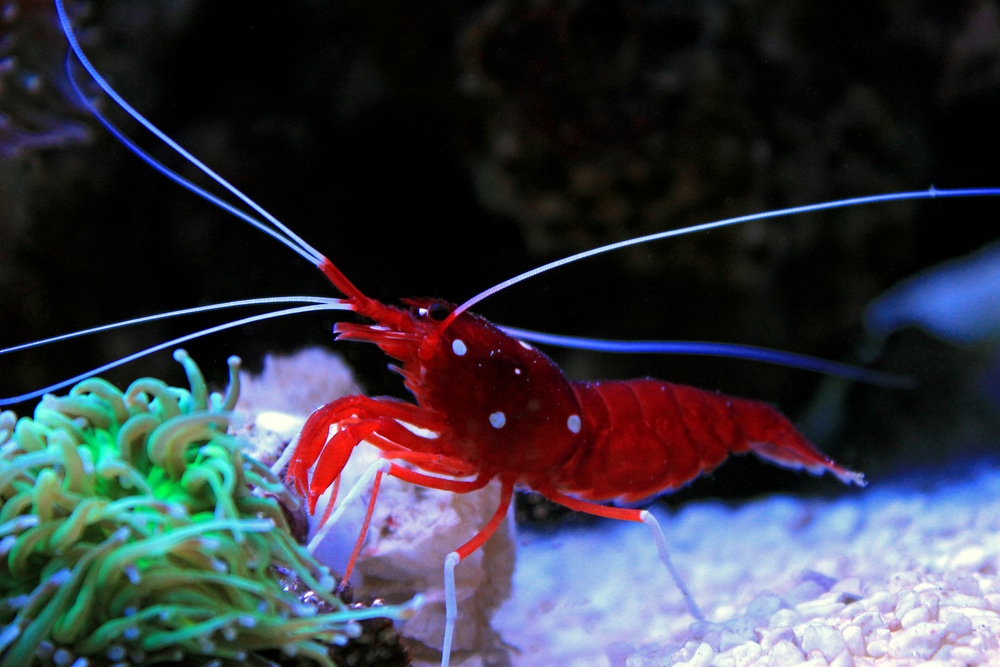
While saltwater aquarium shrimp as a whole tend to be far more striking in appearance than their freshwater cousins the Blood Red Fire Shrimp is one of the most beautiful of all.
Shy and often nocturnal, over time and with regular daylight feedings Blood Red Fire Shrimp become more active during the day and willing to be seen in the open. Once fully acclimated they often set up cleaning stations on rocky or coral outcroppings.
Fish will then rest nearby and allow the shrimp to pick and remove parasites and other skin irritants. While not as active at cleaning as some other cleaners Blood Red Fire Shrimp are moderately large and are a great addition to fish-only tanks.
Blood Red Fire Shrimp can be territorial both towards their own kind and other Shrimp. They do form mated pairs and should have a fairly spacious tank (55+ gallons) if kept with other Shrimp.
They are also easy to feed, accepting the usual prepared and frozen offerings that your fish will eat. Blood Red Fire Shrimp are reported to pick at both stony and soft corals on occasion while other hobbyists report no issues whatsoever. Add to your reef with caution.
- Scientific Name: Lysmata debelius
- Origin: IndoPacific
- Size: Up to 3 inches
- Price: $20-30
- Reef-Safe: With Caution
- Difficulty: Easy
Banded Coral Shrimp
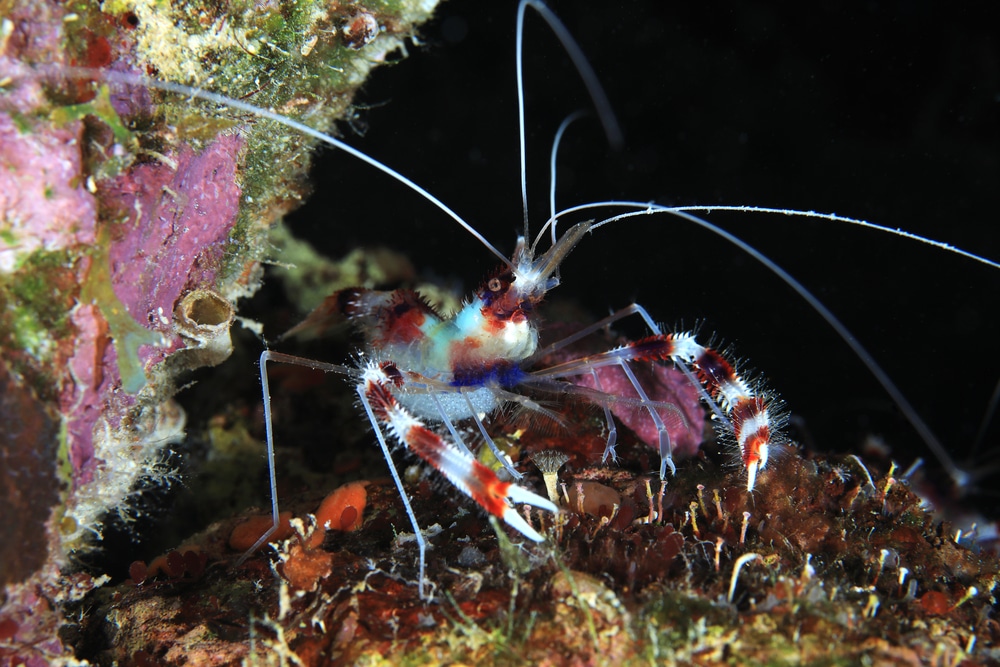
Banded Coral Shrimp are one of the more aggressive types of saltwater aquarium shrimp. While they will occasionally tolerate other species they have no mercy for each other. They will fight to the death even in spacious aquariums and should always be kept single or as a proven mated pair.
Banded Coral Shrimp are also active cleaners and will groom any fish that comes near for skin irritants. Hardy, inexpensive, and striking, they are one of the best first shrimp species for beginners.
One major reason for their popularity is their eagerness to hunt and consume Bristleworms in marine aquaria. While many are benign some are carnivorous and will attack fish when sleeping at night.
There are also three other closely related species with identical care requirements: the Blue Banded Coral Shrimp (Stenopus tenuirostiris), Golden Banded Coral Shrimp (Stenopus scutellatus), and Yellow Banded Coral Shrimp (Stenopus zanzibaricus).
- Scientific Name: Stenopus hispidus
- Origin: IndoPacific
- Size: 3 inches
- Price: $10-20
- Reef Safe: Yes
- Difficulty: Easy
Scarlet Skunk Cleaner Shrimp
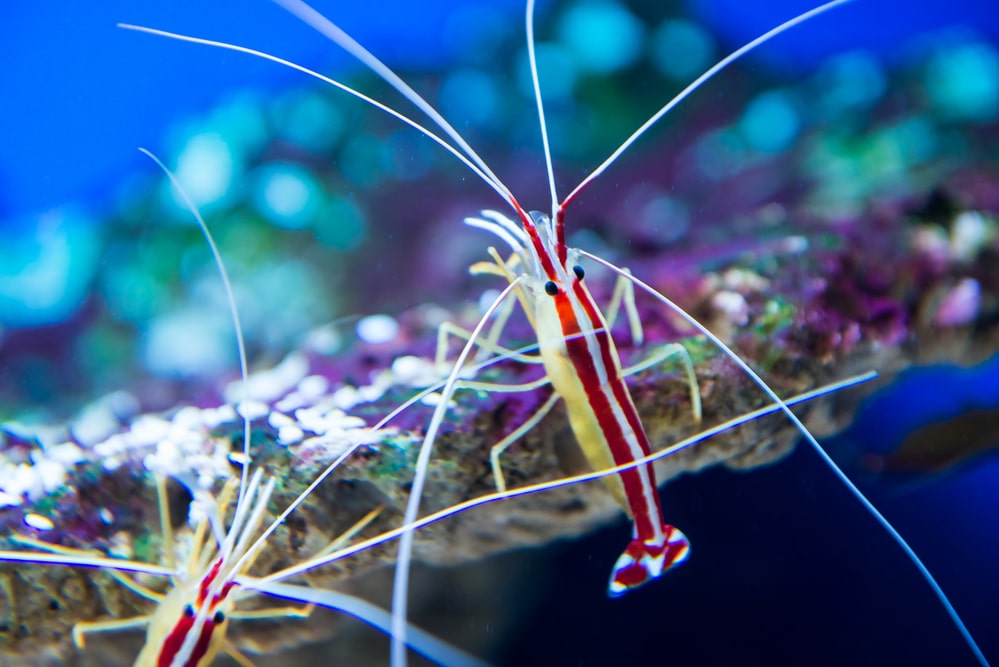
If you’re looking for a Shrimp especially well known for cleaner behavior the Scarlet Skunk Cleaner Shrimp should be your first choice. They are ideal for a wide variety of aquariums, from mostly fish setups to reef aquariums.
In nature, Scarlet Skunk Cleaner Shrimp will even climb willingly into the mouths of large predators to clean out the gill arches and in between teeth. However it’s never a good idea to experiment with this in home aquaria unless your predatory fish were raised with one around.
Scarlet Skunks are peaceful, reef-safe, and can even be kept in groups. In fact, keeping 2 to 3 Shrimp is encouraged as they can be shy and retiring when kept alone.
While brilliantly colored they are also on the smaller side, maxing out at 2 inches. Despite being tiny they are bold and wave their flashy antennae about from coral perches to attract fish in need of grooming.
Scarlet Skunk Cleaner Shrimp will eat a little bit of everything: skin parasites, prepared foods, frozen offerings, and even algae on rocks. They may chase off other similarly sized Shrimp on occasion but never cause harm to their cousins.
- Scientific Name: Lysmata amboinensis
- Origin: Indian Ocean
- Size: 2 inches
- Price: $20-30
- Reef Safe: Yes
- Difficulty: Easy
Peppermint Shrimp
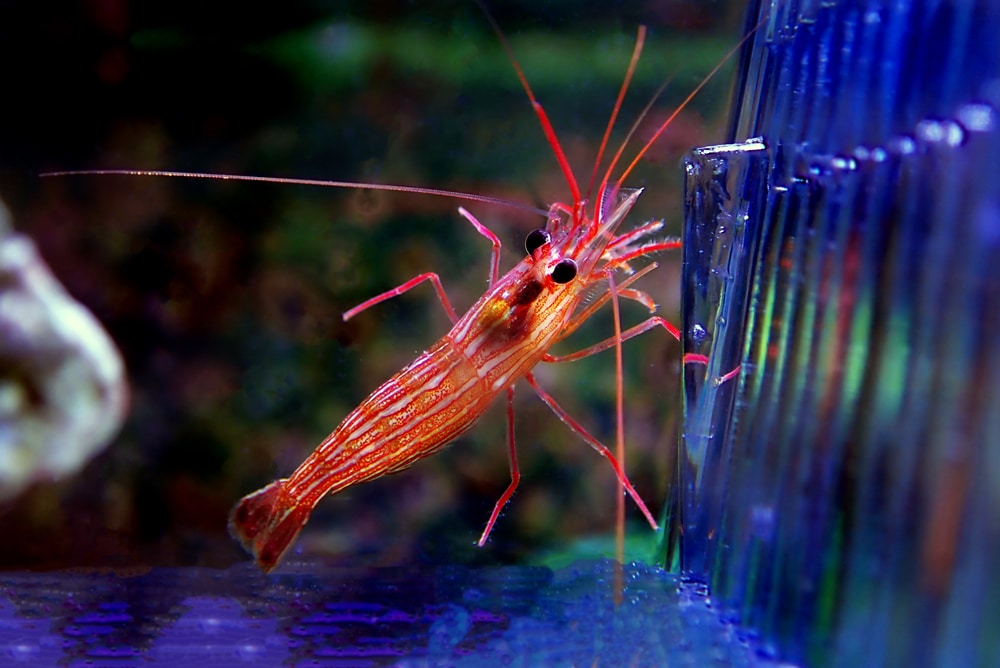
While not as striking as some of their larger cousins Peppermint Shrimp are small, peaceful, inexpensive Shrimp and can be kept singly or in groups. They will exhibit cleaning behavior but aren’t as reliable as other species.
Peppermint Shrimp not only act as cleaner Shrimp but will also hunt and eat Glass Anemones (Aiptasia). These tiny anemones have a tendency to reproduce like crazy and will sting nearby fish and invertebrates indiscriminately.
Some Peppermint Shrimp prefer gorging on less spicy foods and may ignore them. Since they can be kept in groups, however, you should see your Glass Anemone population fall over time. Peppermint Shrimp also prefer slightly cooler temperatures, in the low to mid 70’s.
- Scientific Name: Lysmata wurdemanni
- Origin: Caribbean
- Size: 1½ inches
- Price: $5-10
- Reef Safe: Yes
- Difficulty: Easy
Marbled Shrimp
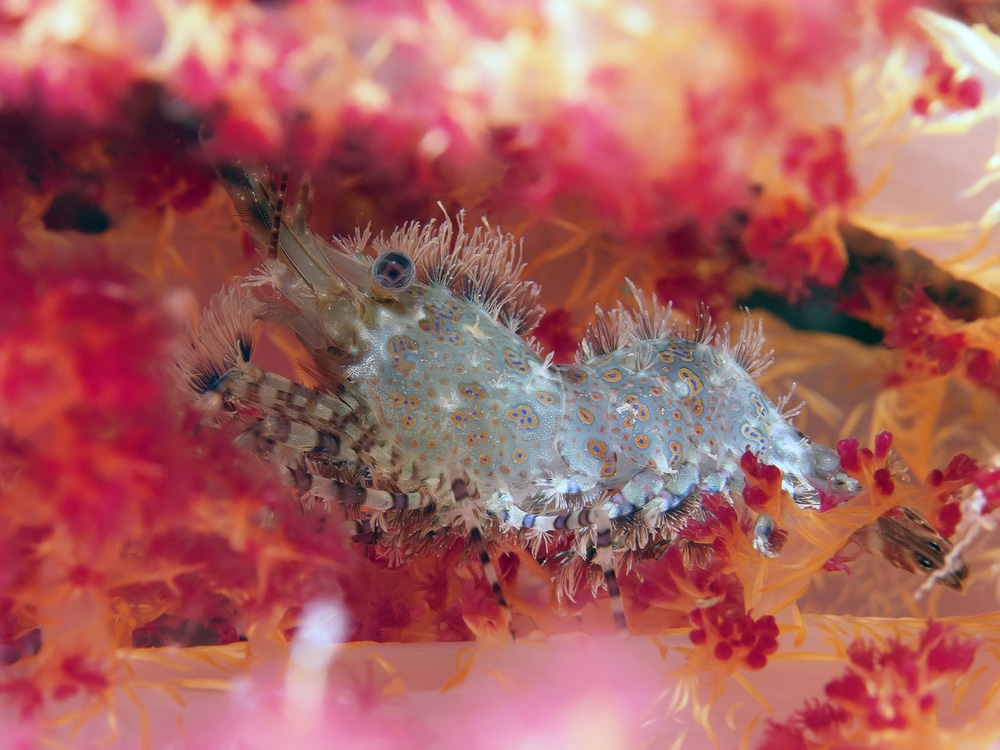
While not cleaners of parasites Marbled Shrimp are excellent at tidying up leftovers from fish meals. They are shy scavengers; in large aquaria full of hiding places you may rarely see yours as they are usually nocturnal.
At night they hunt about for leftover food and will consume nearly anything, including detritus and hidden flakes or pellets. They also take on a red coloration at night which helps them blend into the darkness better as they scavenge.
Marbled Shrimp are peaceful but due to their habit of nibbling a little of everything not reef safe. They will eat polyps if given a chance.
With their subdued yet attractive marbling and tufts along their exoskeletons they are one of the few types of saltwater shrimp that can be sexed reliably. Females have tufts along their first forelegs. And males have long claws free of the bristly growths.
- Scientific Name: Saron marmoratus
- Origin: IndoPacific
- Size: 2 inches
- Price: $5-10
- Reef Safe: No
- Difficulty: Easy
Sexy Anemone Shrimp
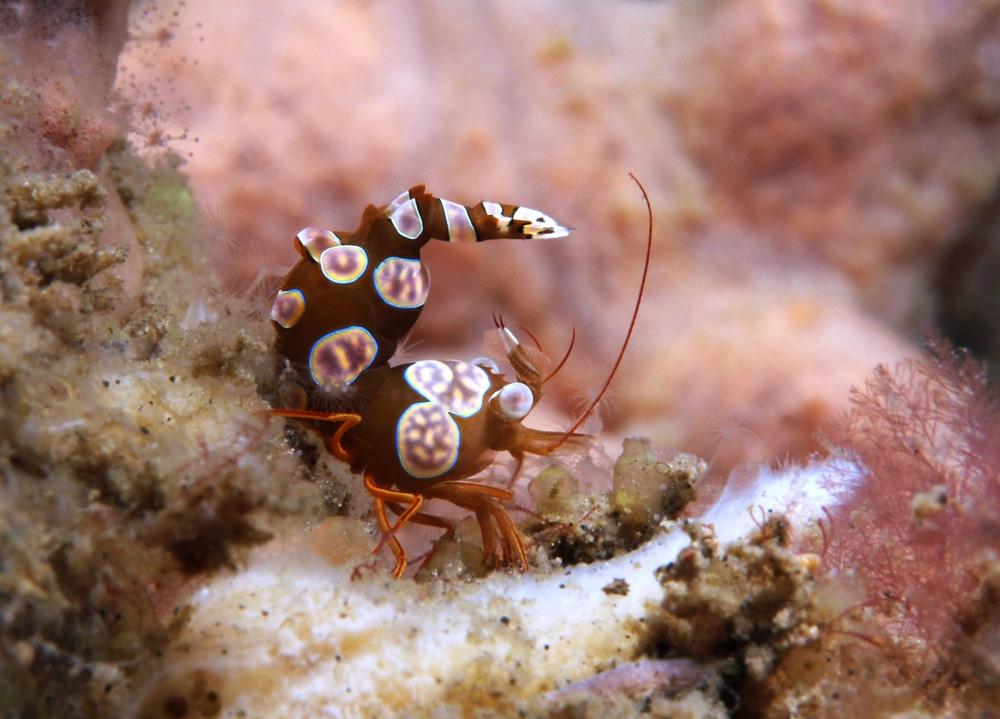
Also known as simply the Sexy Shrimp, this is one of the smallest types of saltwater aquarium Shrimp. Sexy Shrimp are ideal for nano aquariums as they take up so little real estate and can be kept both singly and in groups of any size. They have a distinctive abdomen-waving shimmy that gives them their name and is fun to watch.
In nature Sexy Anemone Shrimp live among the stinging tentacles of a wide variety of anemone species for protection. While too small to fend off most predators they will clean mucus from their hosts and even nibble on tentacle tips from time to time. This makes their relationship a commensal one – the anemone doesn’t benefit but is not harmed, either.
While it seems like a natural pairing they won’t be able to share anemones with Clownfish as the fish will simply eject or eat the pesky Shrimp.
Sexy Shrimp will also bond with corals on occasion, including Duncan’s Coral (Duncanopsammia axifuga) and Clove polyps (Clavularia sp.). Like most Shrimp they are omnivorous and will eat any sort of prepared, frozen, or vegetable matter offered as food.
- Scientific Name: Thor amboinensis
- Origin: Atlantic and IndoPacific
- Size: ¾ inch
- Price: $10
- Reef Safe: Yes
- Difficulty: Easy
Harlequin Shrimp
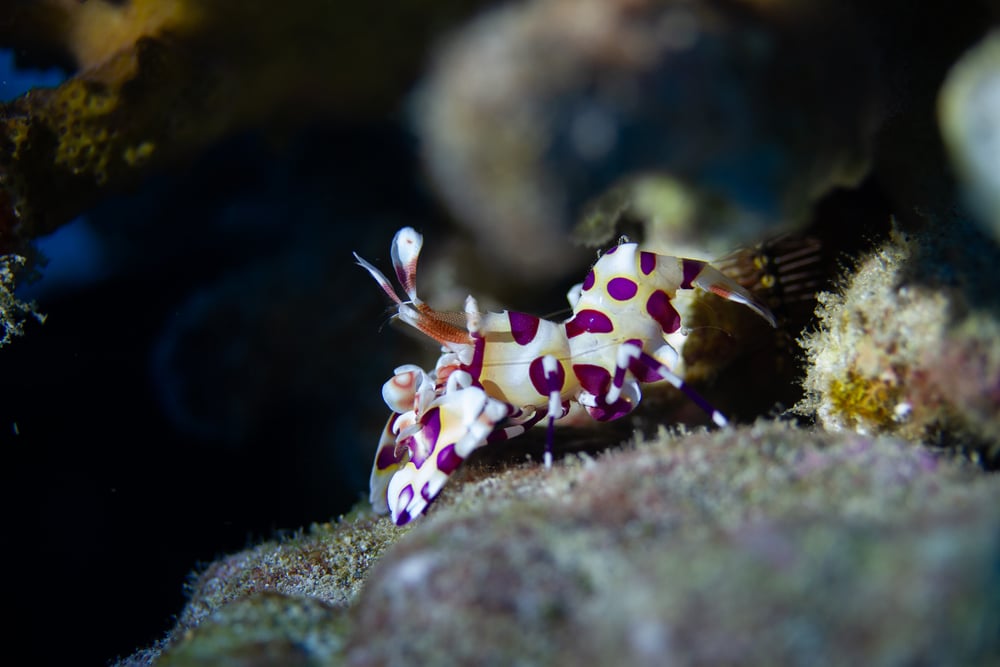
Boldly patterned and active during the day, Harlequin Shrimp would be one of the most popular types of saltwater aquarium Shrimp if not for how difficult they are to feed. They are specialist predators and won’t accept anything except starfish (and occasionally sea urchins) as prey.
This makes feeding complicated and sometimes expensive. While Asterina can sometimes be a numerous pest in aquaria eventually your shrimp will consume all of them and will need supplemental feedings. A single Chocolate Chip Starfish may last a pair of Harlequin Shrimp a week and cost roughly $10.
They live happily as mated pairs and will even hunt together, working to flip over the starfish and drag it to their lair in order to feed on the vulnerable tube feed and insides. So long as you can accommodate their unusual tastes they make excellent additions to marine aquaria.
- Scientific Name: Hymenocera picta
- Origin: IndoPacific
- Size: 2 inches
- Price: $40-50
- Reef Safe: Yes
- Difficulty: Moderate
Bumblebee Shrimp
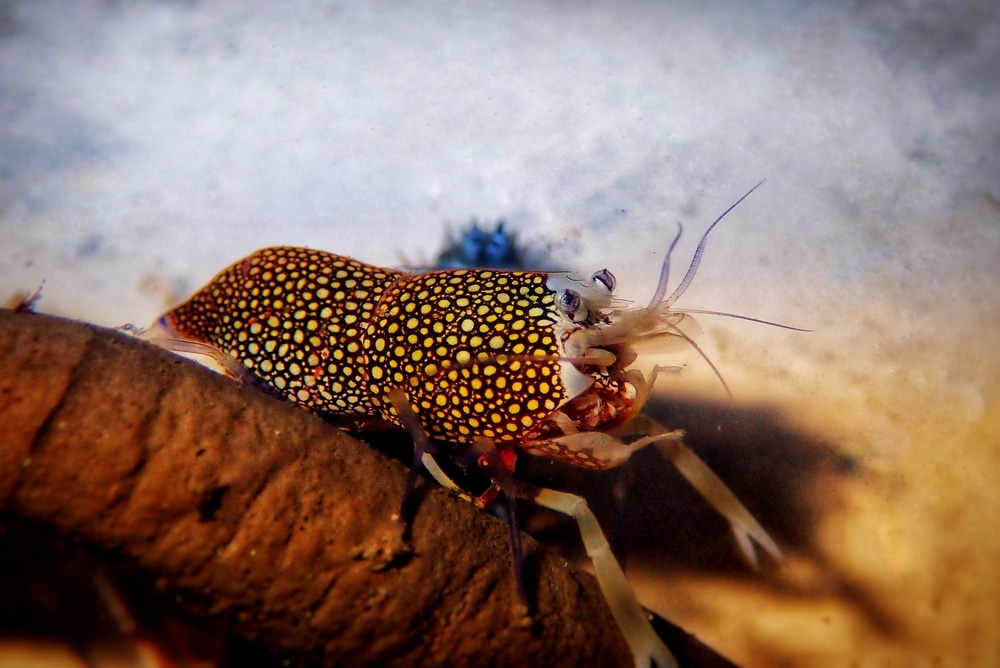
Bumblebee Shrimp are a tiny yet striking type of saltwater aquarium Shrimp well suited for nano aquariums. They reach only an inch in length and when given plenty of shelter are active even during the day. Bumblebee Shrimp are peaceful and can be kept singly or in groups.
Like Harlequin Shrimp, Bumblebee Shrimp will also feed on the tube feet of starfish and other Echinoderms. However they will accept substitutions, including Brine Shrimp and other thawed meaty foods.
As a smaller species Bumblebee Shrimp aren’t a good control mechanism for Asterina population explosions unless kept in large groups.
- Scientific Name: Gnathophyllum americanum
- Origin: IndoPacific
- Size: 1 inch
- Price: $10
- Reef Safe: Yes
- Difficulty: Easy
Pistol Shrimp
Pistol Shrimp are one of the most interesting types of saltwater aquarium Shrimp! They have a specialized claw that creates what’s called a cavitation bubble. The mechanism is complex but they essentially fire a short ranged bullet of water and sonic energy at prey and potential predators.
The effect is quite loud and even produces a brief pulse light as the bubble collapses on itself. Pistol Shrimp use this “bullet” to stun and kill small fish and crustaceans but will adapt to eating dead and prepared foods with ease.
They are generally reef safe but may prey on small Shrimp species, especially if caught in the middle of a molt when their shells are soft.
There are several species of Pistol Shrimp in the aquarium trade and nearly all are burrowers that prefer a deep, fine sand substrate. They will then create a tunnel that they actively defend and rarely leave except to feed.
Many Pistol Shrimp will also form mutualistic relationships with Shrimp Gobies: the Goby has much better eyesight and acts as an alarm for the Pistol Shrimp. The Shrimp often keeps a single antenna on the Goby, tracking its location at all times. The Goby shares the burrow with the Pistol Shrimp and occasionally collects and offers food to its roommate.
Unfortunately, replicating this relationship in aquaria is difficult to impossible as different species and individual Gobies pair with different species of Pistol Shrimp. Also, both need to be added at once without the Goby simply claiming an easy rock cave and being unwilling to move once the Pistol Shrimp finishes its new home.
- Scientific Name: Alpheidae family
- Origin: Worldwide
- Size: 1 to 3 inches
- Price: $20-40
- Reef Safe: Yes
- Difficulty: Easy to Moderate
Camel Shrimp
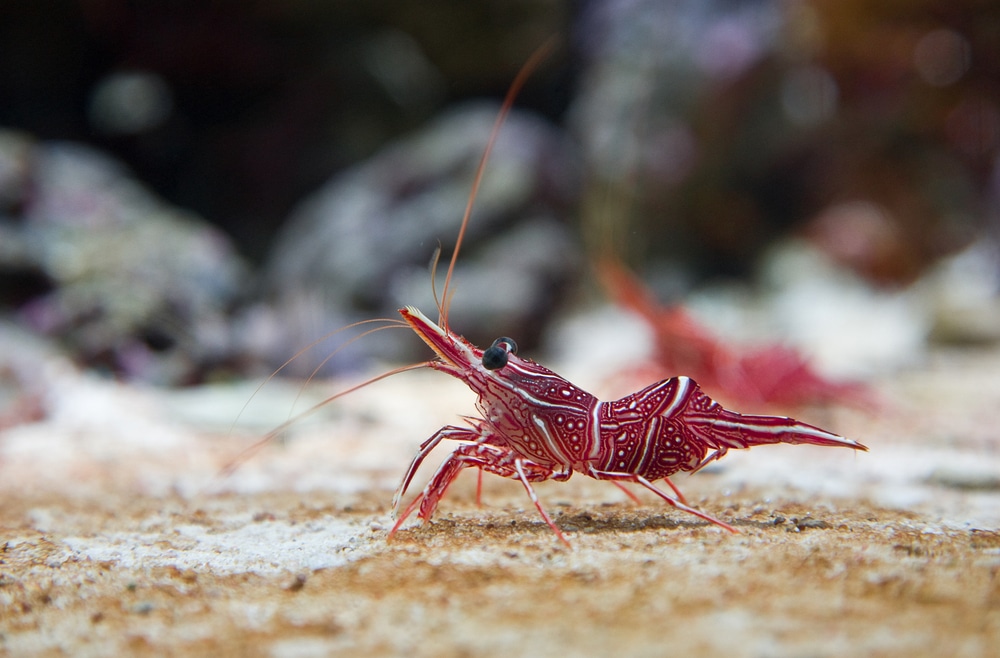
Camel Shrimp are superficially very similar to Peppermint Shrimp however they have a very pronounced hump on their abdomen, reflecting eyes, and usually bolder white stripes.
Their large, reflective eyes are clues to their nocturnal nature. While Camel Shrimp will adapt to daytime feeding they do most of their wandering at night, safe from most predators. They hunt for leftover food and other detritus that collects in the aquarium and are excellent housekeepers.
Whether Camel Shrimp are reef safe is up to debate and the whims of your Shrimp. Many aquarists find that well fed Camel Shrimp are harmless to corals while others find they tend to graze on them.
Bubble Coral and stinging anemones are thought to be safe from Camel Shrimp but again, not guaranteed. While they are beautiful additions to reef aquaria I can only recommend caution when trying them for yourself.
- Scientific Name: Rhynchocinetes durbanensis
- Origin: Pacific
- Size: 2 inches
- Price: $10
- Reef Safe: With Caution
- Difficulty: Easy
Peacock Mantis Shrimp
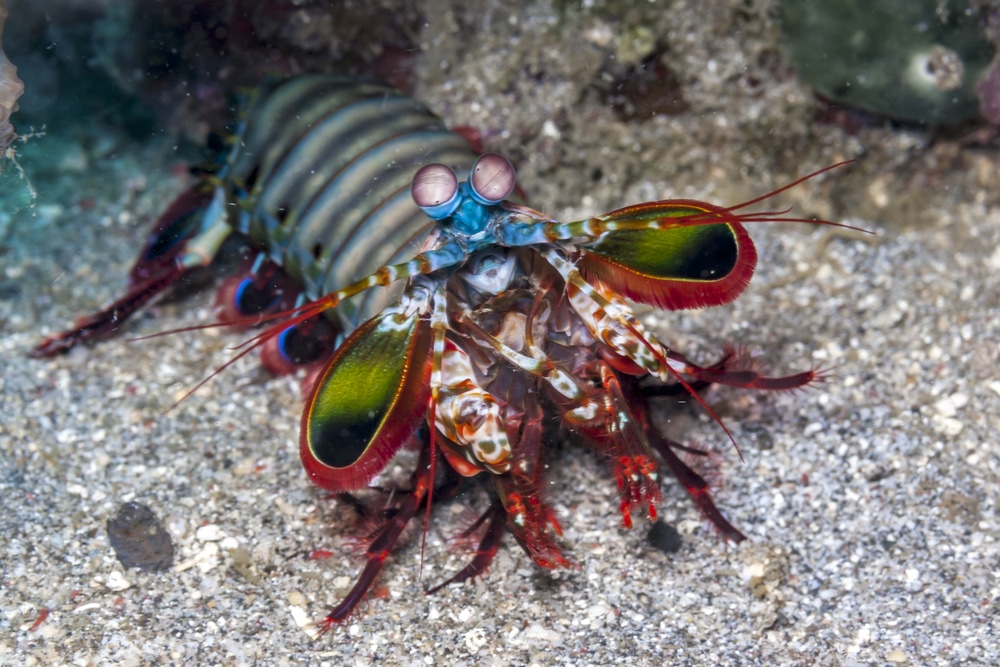
Disclaimer: Mantis Shrimp are not true Shrimp; they are actually crustaceans known as Stomatopods. However, since they are superficially similar and are always called Shrimp they deserve to be included.
Mantis Shrimp are famous for both their eyesight and active, predatory nature. They come in two varieties: spearers that have a razor sharp forelimb and smashers with a club-like one. Both types whip this limb at incredible speed to both kill prey and defend themselves from predators.
Peacock Mantis Shrimp are relatively large, reaching up to 8 inches and are vibrantly colored in greens, blues, and red tones. As a “smasher” type they have twin clubs capable of cracking aquarium glass if caught at the right angle and with enough force, however this almost never happens. Usually this occurs with large adults kept in a small tank provoked into striking out.
However the danger is there. Peacock Mantis Shrimp often secure their prey against rocks – or glass – and strike repeatedly to crack the shells of crabs, clams, shrimp, and other hard shelled prey. They will also accept soft meaty items like fish and thawed shellfish.
While hardy Peacock Mantis Shrimp are fast, incredibly aggressive predators with excellent eyesight and are like no other saltwater aquarium shrimp. They should be kept in tanks with no other inhabitants as they will eventually eat or maim everything else around them.
- Scientific Name: Odontodactylus scyllarus
- Origin: IndoPacific
- Size: Up to 8 inches
- Price: $50-100
- Reef Safe: No
- Difficulty: Moderate to Difficult
Pederson’s Cleaner Shrimp
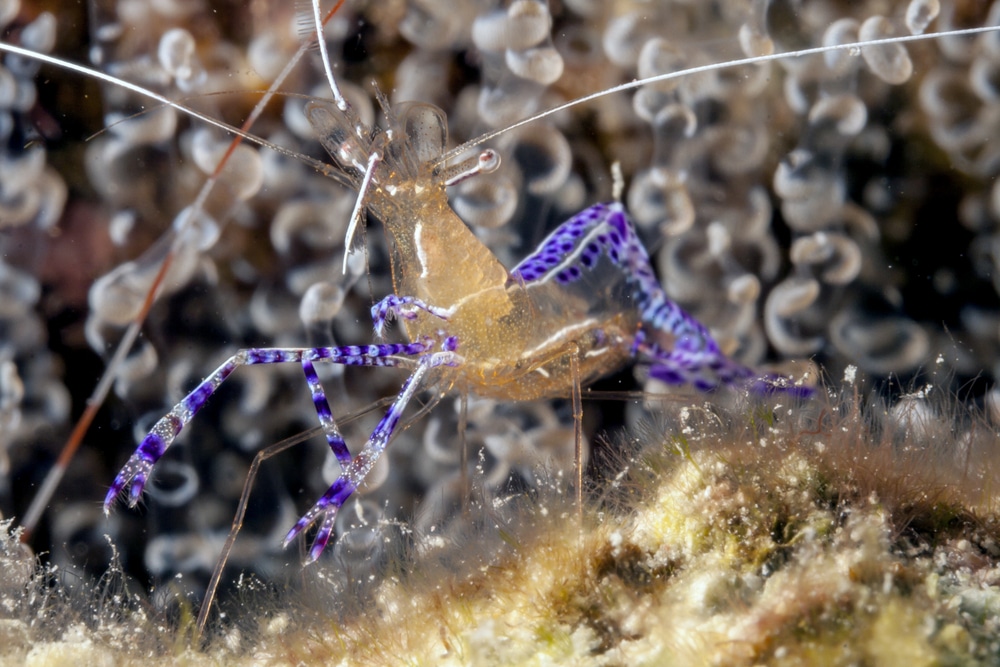
Pederson’s Cleaner Shrimp is a small, peaceful Caribbean species that not only acts as a cleaner but also forms commensal relationships with anemones for protection. Their bold white antennae advertise their services and the tiny shrimp will climb over even large predatory fish, searching for parasites to remove.
While their relationship with anemones is fascinating Pederson’s Cleaner Shrimp do not require one to be happy in home aquariums.
Pederson’s Cleaner Shrimp are sociable and do best in groups of 3 or more. They are also omnivorous and will accept any prepared or frozen offerings and will scavenge detritus from crevices and the substrate.
- Scientific Name: Ancylomenes pedersoni
- Origin: Caribbean
- Size: 1 to 1½ inches
- Price: $20-30
- Reef Safe: Yes
- Difficulty: Easy

